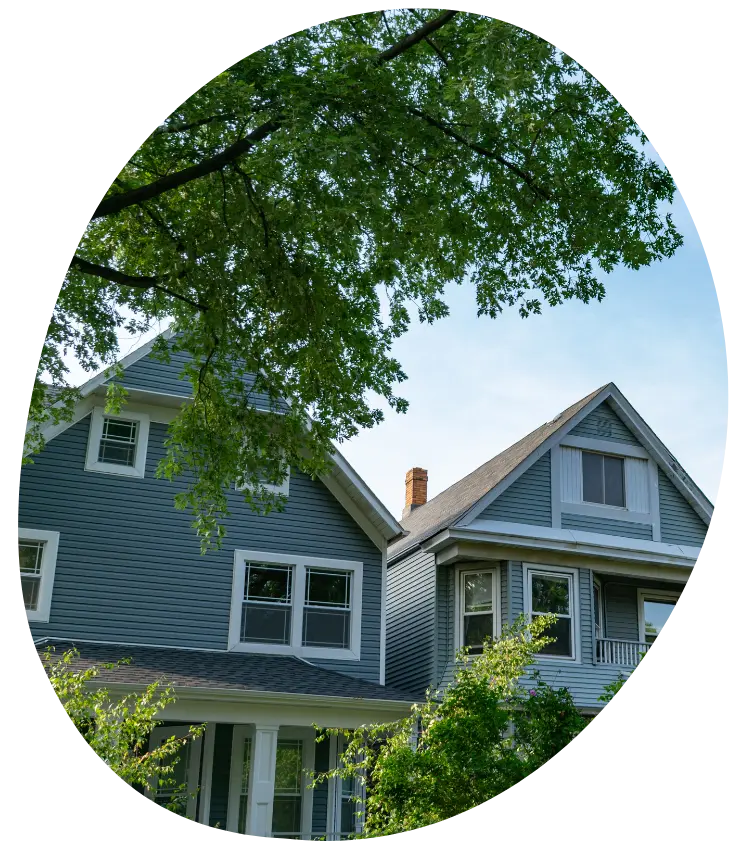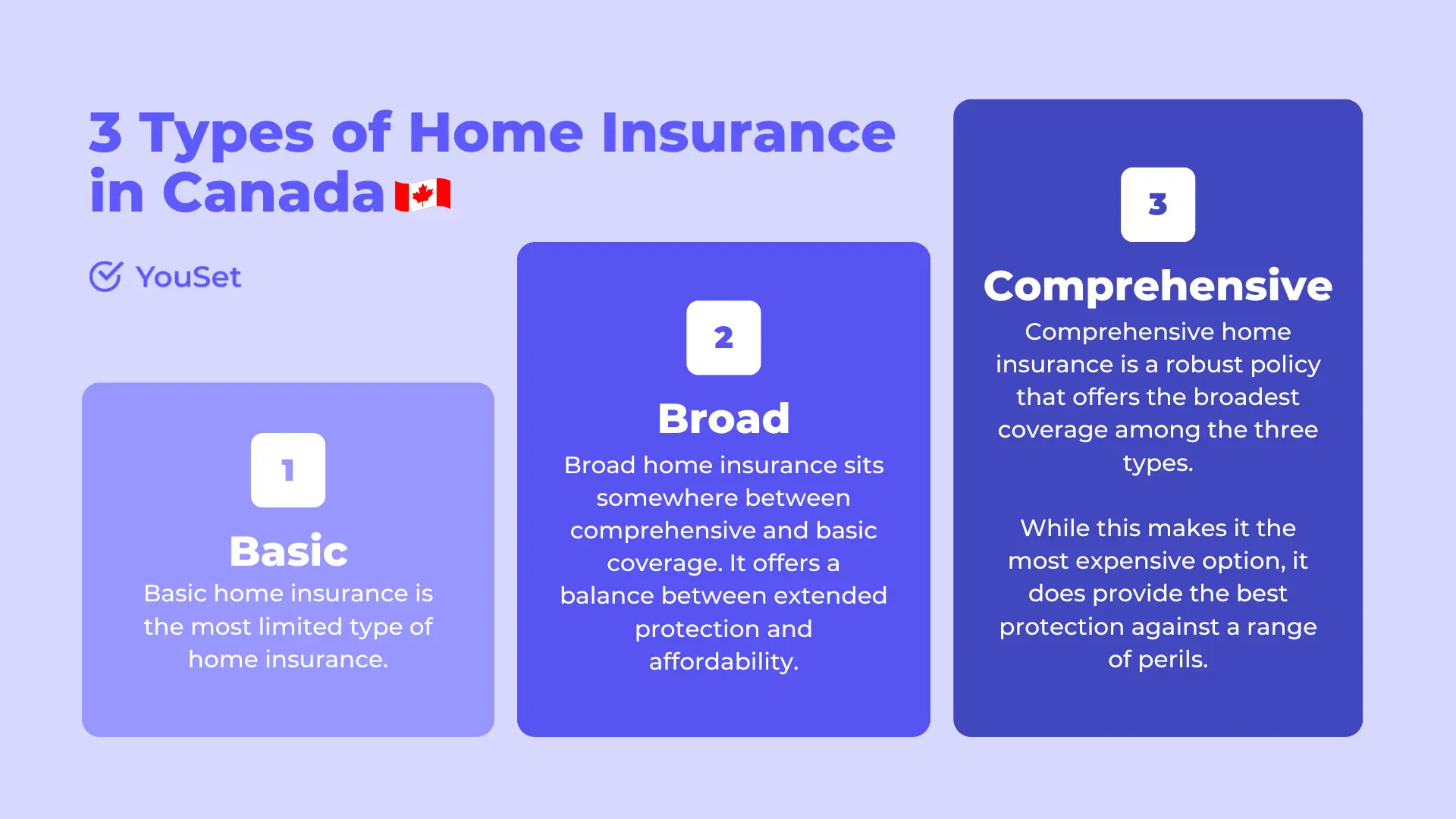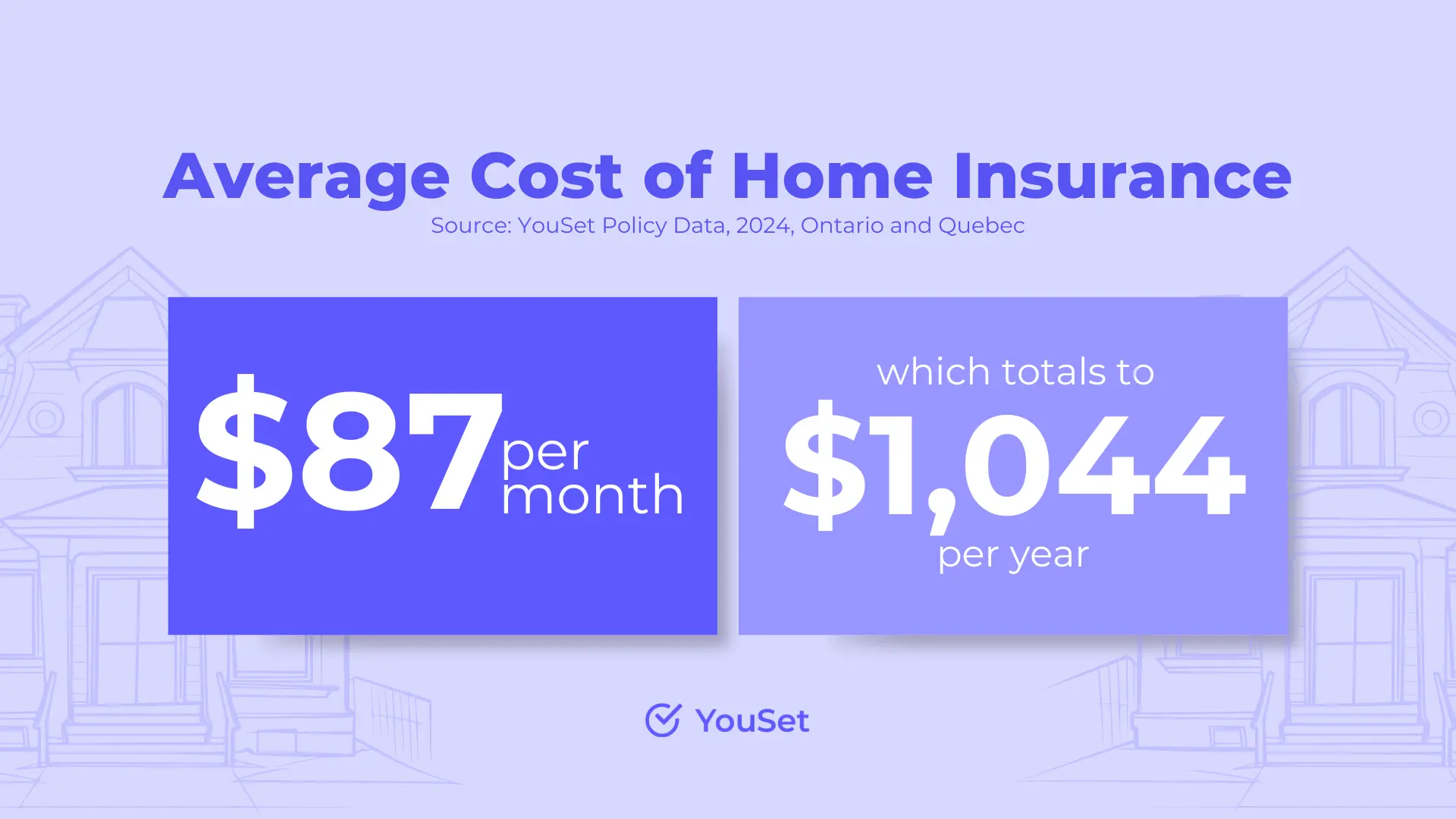Home Insurance 101:
A Guide and Glossary for Canadians
Your home is one of, if not, the most significant investments you’ll make in your lifetime. It embodies a culmination of sacrifices and represents the journey you undertook to achieve homeownership – a journey marked by hard work, dedication, and resilience. It’s only natural then, that you would want to protect that which you have worked so tirelessly to call your own, not just from the elements, but from the challenges life will inevitably throw your way. This is where home insurance comes in.
Think of home insurance as a safety net. When the unexpected happens, home insurance alleviates the burden of paying for repairs or replacements out of pocket, allowing you to recover and rebuild without facing significant financial strain. In addition to protecting the physical structure of your home, home insurance extends to personal belongings and liability claims as well, which means you can rest easy knowing that your financial interests are secure should the worst happen.
In this beginner-friendly guide, we aim to simplify the often daunting world of home insurance in Canada. Whether you’re a first-time homeowner or are an experienced one, this guide simplifies intricate concepts into easily digestible explanations so that you feel empowered to make more informed decisions. The included glossary of home insurance terms is also a handy reference, worthy of bookmarking should you encounter unfamiliar terminology as you embark on the journey of finding the best home insurance for the lowest price.

Table of Contents | 20-minute read |
By definition, home insurance is a form of property insurance designed to safeguard you and your home against unforeseen events and liabilities, such as fire, theft, and water damage. Simply put, it’s an additional layer of protection against the unexpected.
In Canada, coverage for civil liability, dwelling and detached structures, personal belongings, and additional living costs are usually included in all home insurance policies. For homeowners who want additional protection though, you can customize your policy by selecting from a variety of optional coverages, such as theft or water damage. Ultimately, this decision is entirely your choice and will depend on your circumstances and preferences.
No – You are not legally required to have home insurance in Canada.
However, mortgage lenders and banks make home insurance mandatory for those whose homes are not fully paid off. In fact, you will need to provide proof of insurance to be able to secure a mortgage or line of credit. They do this to ensure that the property, which serves as collateral for the loan they are providing you, is adequately protected against risks, thereby safeguarding their investment.
Living without home insurance poses significant risks if you lack the financial means to pay for repair costs, replace ruined belongings, or cover the legal costs associated with a liability lawsuit. Consider the extensive, sometimes catastrophic damage that perils like fire and water accidents can inflict on your home. If you were uninsured when such an event occurs, the cost to repair or rebuild could severely compromise your financial stability, setting back your goals by months, if not years.
This is why it is so important for the following types of homeowners to insure their property:
- Homeowners with a mortgage
- Homeowners without a mortgage
- Condo owners
- Cottage, chalet, lake house, and vacation homeowners

Homeowners with a mortgage
If you have a mortgage, home insurance is typically required by your lender and bank to protect both your and their interests. Not to mention, it ensures that damage caused to the structure of your home, the personal belongings within it, and any liability risks are adequately covered.
Homeowners without a mortgage
Even if you own your home outright (and are therefore not required to have insurance), you still need to protect your investment. Plus, home insurance covers more than just your home’s structure. It encompasses coverage for your personal belongings, shields you from liability, and offers assistance with additional living expenses in the event your home becomes uninhabitable due to a covered incident.
Condo owners
It’s a common misconception that the insurance held by your condo association extends to you. While their policy insures common areas such as elevators and lobbies, it does not extend to individual units. In order to protect your unit, personal belongings, liability, and any upgrades you’ve made, you need condo insurance, which is essentially home insurance that is customized to meet the unique requirements of condo ownership.
Vacation homeowners
For owners of cottages, chalets, or lake houses, vacation home insurance is essential. It covers damage to the physical structure, as well as personal belongings kept on the property, which is especially important given that this type of property can remain unoccupied for extended periods of time, such as during the winter months.
Standard home insurance policies in Canada typically cover personal property, personal belongings, personal liability, additional living costs, and detached structures. However, there are plenty of optional coverage options available that you can add to customize your policy so that it best suits your needs and preferences.
Here’s an overview of what home insurance typically covers. Keep in mind that while this is not an exhaustive list, it will give you a sense of what coverage you want and what coverage you may not need.
- Dwelling
- Personal belongings
- Civil liability
- Additional living costs
- Detached structures
- Water damage
- Theft and burglary
- Floater
- Identity theft
- Earthquakes
Dwelling
Dwelling coverage is the part of home insurance that protects the physical structure of your home itself. It covers the main building, including its foundation, walls, roof, floors, and attached structures like a garage or deck. So, if a covered incident, such as a fire, were to happen, your insurer would help cover the cost of repairing or rebuilding your home up to the amount specified in your policy.
Personal belongings
Personal belongings coverage, also known as contents insurance, insures your personal belongings against loss or damage caused by insured perils, such as vandalism or water damage. With it, your belongings are insured wherever you may be, so long as you’re only away from your home temporarily. For example, if your laptop gets stolen from your hotel room during a vacation, personal belongings coverage would help cover the cost of replacing it.
Civil liability
Civil liability coverage protects you against potential lawsuits stemming from accidental injury or property damage caused by you or your household members. This means that if you find yourself in a situation where you may be held liable for harm caused to others or their property, whether at your home or not, civil liability coverage may pay for a portion of the associated legal expenses, medical bills, and potential damages awarded to the injured party.
Additional living costs
Additional living costs coverage provides financial assistance for the expenses incurred if you’re unable to temporarily live in your home due to damage from a covered event. This typically includes costs such as hotel stays, temporary apartment rentals, and essential food expenses, all so that you can maintain your usual standard of living while your home is repaired or reconstructed.
Detached structures
Your home is more than just the house itself, and detached structures coverage takes this into account. With this coverage, detached structures on your property that are not physically connected to the main dwelling, such as sheds, garages, guest houses, greenhouses, and pool houses are insured up to the amount specified in your policy.
Water damage
Water damage coverage protects you against damage caused by water-related incidents. Insurers will typically offer coverage for three types of water damage, including sewer backup, overland water, and above-ground water coverage. However, depending on the insurer and policy, it may not be automatically included and may need to be added as optional coverage.
Theft and burglary
Theft and burglary coverage provides you with financial reimbursement should your personal belongings be stolen, or your house be damaged during a break-in. This is typically considered optional coverage and would need to be added to your policy. Also, it’s important that you inform your insurer about any high-value items you acquire, as coverage limits may apply to items such as expensive jewelry, art, or electronics, in the event of theft.
Floater
Floater insurance is an optional policy extension that can be added to insure valuables against perils such as theft, vandalism, and fire. So, if you have high-value items such as jewelry, fine art, or collectibles that go beyond the standard coverage limits of your home insurance policy, a floaters policy would ensure the value of those items is covered for replacement, although some limitations may apply.
Identity theft
Identity theft coverage protects policyholders against the growing threat of identity fraud in Canada. It is usually considered optional, so you would need to add it to your home insurance policy to receive reimbursement for legal expenses incurred during the process of replacing stolen documents and reclaiming your identity.
Earthquakes
Earthquake coverage protects your home against damage resulting directly or indirectly from earthquakes, as well as related events such as snow slides, landslides, and earth movements. Depending on where you live in Canada and how prone that area is to this type of event, this optional coverage might be well worth the additional cost.
While home insurance offers extensive protection, one must recognize that there are some limitations. As such, here is a list of what home insurance typically does not cover in Canada:
- Damage caused by lack of maintenance
- Normal wear and tear
- Pest infestations
- Mold
- Rot
- Intentional damage
- Business activities
- High-value items that surpass the standard limits
- Cars
- Vacant home
In Canada, there are generally three types of home insurance for you to choose from: comprehensive, basic, and broad. The difference between them is the level of coverage, ranging from the bare minimum to extensive protection for various risks and perils.
Selecting the right type requires you to assess your specific needs, consider what you could afford to pay out of pocket should a claim not be covered by your policy, and then find a balance between the coverage and cost that aligns with your current financial situation and risk tolerance.
To help you do this, here’s an explanation of the three main types of home insurance in Canada:
- Comprehensive (All-risks)
- Basic (Named perils)
- Broad

Comprehensive home insurance
Comprehensive home insurance, which can also be referred to as all-risks home insurance, is a robust policy that offers the broadest coverage among the three types. While this makes it the most expensive option, it does provide the best protection against a range of perils such as fire, theft, vandalism, natural disasters, and liability claims. It’s worth noting that some providers, like YouSet, exclusively offer comprehensive home insurance, catering specifically to homeowners wanting maximum security for their property and possessions.
Basic home insurance
Basic home insurance, which can also be referred to as named perils home insurance, is a more limited policy compared to the comprehensive option. It protects your home and belongings only against specific perils explicitly listed in the policy. While this typically makes it the most affordable option, remember that the lower cost often correlates with less coverage. What this means is that you will need to be financially prepared to cover the cost of damages or losses not covered by a basic policy out of your own pocket.
Broad home insurance
Broad home insurance sits somewhere between comprehensive and basic coverage. It offers a balance between extended protection and affordability. While it protects your home and belongings against a variety of perils, it may offer less exhaustive coverage than a comprehensive policy would. Given this, it is typically chosen by homeowners who want more protection than a basic policy provides but are also budget-conscious.
The cost of home insurance is going to depend on many factors, including where you live, the type of property you own or rent, and the amount of coverage you opt for. However, to give you a sense of how much home insurance is in Canada, here are the average monthly and yearly prices of home, condo, and tenant insurance among YouSet users. You can also find out how much people in your area pay by giving this home insurance calculator a try.
| Average Cost of Home Insurance Per Month | Average Cost of Home Insurance Per Year | |
| Homeowners | $87.00 | $1,044.00 |
| Condo | $31.00 | $372.00 |
| Tenant | $23.50 | $282.00 |
*Source: YouSet Policy Data, 2024, Ontario and Quebec
Price of homeowners insurance
According to YouSet policy data, home insurance costs an average of $87 a month in Ontario and Quebec. At its lowest, it costs $75 a month, while at its peak it costs $135 a month. This means home insurance costs YouSet customers between $900-$1,620 per year.
Price of condo insurance
According to YouSet policy data, condo insurance costs an average of $31 a month in Ontario and Quebec. At its lowest, it costs $15 a month, while at its peak it costs $75 a month. This means condo insurance costs YouSet customers between $180-$900 per year.
Price of tenant insurance
According to YouSet policy data, tenant insurance costs an average of $23.50 a month in Ontario and Quebec. At its lowest, it costs $12 a month, while at its peak it costs $50 a month. This means tenant insurance costs YouSet customers between $144-$600 per year.

When you’re ready to buy a policy, there are many reputable home insurance companies in Canada to choose from, including:
Remember, home insurance is not a one-size-fits-all. While an insurer might come highly recommended to you by a friend or family member, there’s always a chance that they can’t offer you the price, perks, or coverage you need. So instead focus on shopping around, doing your research, and asking questions. It’s the best way to ensure you end up with the right insurance for you and your loved ones.
Home insurance terms glossary
The home insurance industry is rife with jargon. Terms like deductible, premium, and peril get used left, right, and center, with the assumption that everyone understands what they mean. While those in the industry or who have been buying insurance for decades might, there are many Canadians who feel like they need a decoder ring just to buy home insurance.
If that sounds familiar, you’ve come to the right place. Think of this home insurance terms glossary as your trusted decoder ring. It includes straightforward definitions paired with relatable examples for the most commonly used terms. With it on hand, you’ll be able to navigate the world of home insurance with a greater sense of confidence, which is important if your goal is to get all the coverage you need for the best price.
A • B • C • D • E • F • G • H • I • J • K • L • M • N • O • P • Q • R • S • T • U • V • W • X • Y • Z
Actual cash value
Actual cash value refers to the current market value of damaged or lost property, considering its age and wear and tear. Again, say your television gets stolen from your home. If your home insurance policy covers personal property at actual cash value, your insurer will reimburse you for the value of the TV given its age and condition, not for the cost of buying a brand-new one.
Additional living costs
Additional living costs refer to the expenses associated with having to live elsewhere temporarily should a covered loss, like a fire or natural disaster, make your home uninhabitable. For example, if your home sustains severe wind damage, making it unsafe to live in until repairs are completed, your home insurance may cover the cost of temporary accommodation, such as staying in a hotel, as well as additional living expenses like meals and transportation.
Adjuster
An adjuster is a professional employed by your insurer whose job is to assess the extent of the damage or loss to your home and determine the compensation you’re owed. For example, if you file a claim after a major house fire, an insurance adjuster will visit your home to inspect the damage, assess the cost of repairs, and help facilitate the claims process with your insurer.
Appraisal
An appraisal is a formal evaluation conducted by a certified appraiser to determine the value of a property. For example, you might have high-value or specific items appraised before a loss occurs so that you can back up any potential claim more effectively.
Claim
A claim is a request you make to your insurer when a covered loss or damage occurs that you want financial compensation for. For example, if a tree falls on your roof during a storm, causing significant damage, you would file a claim with your home insurance company to receive funds for repairs or replacements.
Coverage
Coverage refers to the types of risks and perils that are covered by your policy for which your insurer will offer compensation in the event of a claim. For example, if you purchase fire, theft, and liability coverage, it means that your insurance company will provide financial assistance if your house catches fire, gets burglarized, or if someone gets injured on your property.
Covered loss
A covered loss refers to a damage or loss to your home that is included in your policy and is therefore eligible for financial compensation. For example, if a fire in your kitchen damages your cabinets and appliances, and your insurance policy includes fire damage coverage, then the cost of repairing or replacing the said items would be a covered loss.
Deductible
A deductible is the amount of money you agree to pay out-of-pocket should you file a claim. For example, if you have a $500 deductible and your house suffers $2,000 worth of damage in a fire, you’d pay the $500 and then your insurer would cover some, if not all, of the remaining $1,500.
Dwelling
A dwelling refers to the primary structure on a residential property, including its foundation, walls, roof, floors, and attached fixtures. In other words, a dwelling is the physical structure of your home.
Dwelling coverage
Dwelling coverage refers to the part of your insurance policy that protects the structure of your home itself, including the walls, roof, and floors, against covered perils. For instance, in the event of a house fire causing damage to your roof, dwelling coverage would step in to alleviate the financial burden by covering the costs associated with its repair.
Endorsement
In home insurance, an endorsement is an extra addition that you can add to your policy, which changes or adds to the original terms. Every insurance company starts with a basic home policy, which you can then customize the coverage by adding endorsements.
Exclusion
An exclusion is a specific type of damage or peril that is not covered by your insurance policy. For example, if your home insurance policy excludes coverage for damage caused by floods, you would not be able to file a claim and get compensated for any damage to your home that’s caused by a flood.
Floater
A floater in home insurance is a separate policy or addendum to your home insurance policy that provides coverage for specific high-value items that exceed the coverage limits of your standard policy. For example, if your engagement ring exceeds the limits of your policy, a floater can provide you with additional coverage to replace the ring at its full value should it be damaged or stolen.
Lapse in coverage
A lapse in coverage happens when there’s a gap in time between the expiration of your old policy and the effective date of your new one, leaving you fully financially responsible in the interim. You want to minimize the number and length of any lapses in coverage as insurers will take these gaps into consideration when assessing your risk profile and determining premiums for future policies.
Liability
Liability in home insurance refers to your legal responsibility for accidents or injuries that occur on your property or as a result of your actions. For example, if a visitor slips and falls on your icy driveway and they sue you for negligence, liability coverage would help cover the associated medical or legal expenses.
Peril
A peril refers to an unexpected or unpredictable event that may cause damage or loss to your property. Some examples of commonly insured perils include explosions, falling objects, fire, theft, vandalism, wind, hail, and water damage.
Personal belongings
Personal belongings refer to items you own, such as furniture, electronics, clothing, art, and jewelry, which are covered by your insurance policy if they’re damaged, stolen, or destroyed. For example, if your home is burglarized and your electronics are stolen, home insurance would contribute to the cost of replacing those items.
Policy
A home insurance policy is the legal contract between you (the homeowner) and your insurance company. Your policy document will include information such as your premium amount, deductibles, covered perils, and exclusions, as well as terms and conditions outlining the rights and responsibilities of both parties.
Policyholder
A policyholder refers to the individual or entity who owns the insurance policy and is entitled to the benefits and coverage outlined within it. For example, if you’re the homeowner who purchases and maintains the insurance policy, as well as protects the home against risks such as fire, theft, or liability claims, then you would be the policyholder.
Policy limit
A policy limit refers to the maximum amount your insurance will cover for a particular type of loss or damage. For example, if your home insurance policy has a policy limit of $300,000 for dwelling coverage, that means your insurer will pay for repairs or rebuilding of your home in the event of a covered loss is $300,000.
Premium
A premium is the amount of money you pay for home insurance over a specific period, typically annually or monthly. For example, if your annual premium is $1,200, you must pay that amount to your insurance company in order to maintain coverage for potential risks such as fire, theft, or liability claims.
Replacement cost
Replacement cost refers to the amount of money needed to replace or repair damaged property with new items of similar kind and quality, without taking into account any decrease in value due to age or wear and tear. For example, say your television gets stolen from your home. If your home insurance policy covers personal property at replacement cost, your insurer will reimburse you for the cost of a new TV that’s similar in size and quality.
Underwriting
Underwriting refers to the process insurance companies use to evaluate the risks associated with insuring you and your home. They’ll look at things like the age and condition of your house, any past claims you’ve made, and even your credit history to determine if they’re willing to insure you and if they are, how much they’ll charge you for insurance.
Next Steps: Get Better Home Insurance for Less
Regardless of whether you’ve just stepped into homeownership or have decades of experience under your belt, there’s a universal objective among homeowners – find the best insurance at the most affordable price.
While understanding the basics of home insurance in Canada, as you’ve learned in this guide, is crucial, it alone might not be enough. What you might also need to do is tap into the expertise and insights of a seasoned team of insurance experts who help homeowners like yourself achieve their goals, day in and day out. This is YouSet. A free, user-friendly online platform built by industry professionals that automatically compares prices from multiple insurers and applies exclusive discounts, all so that you can buy better home insurance online for less money and in less time.



